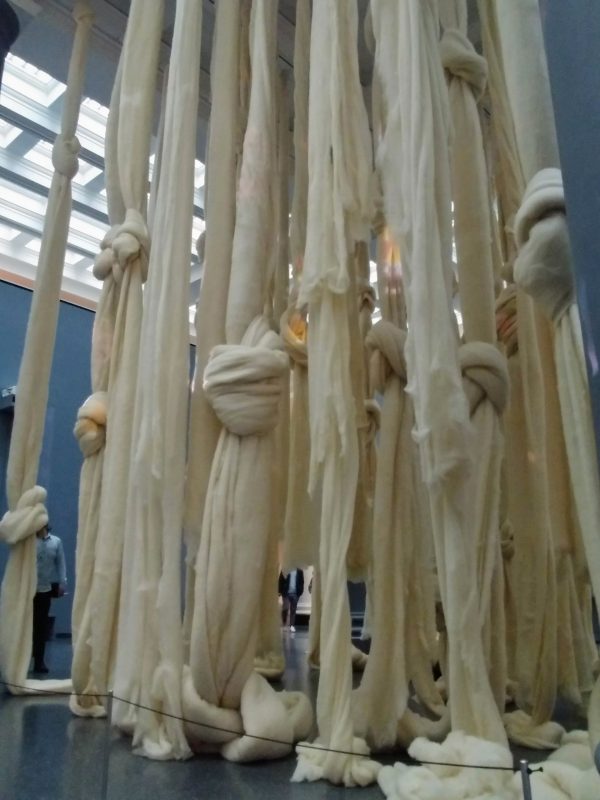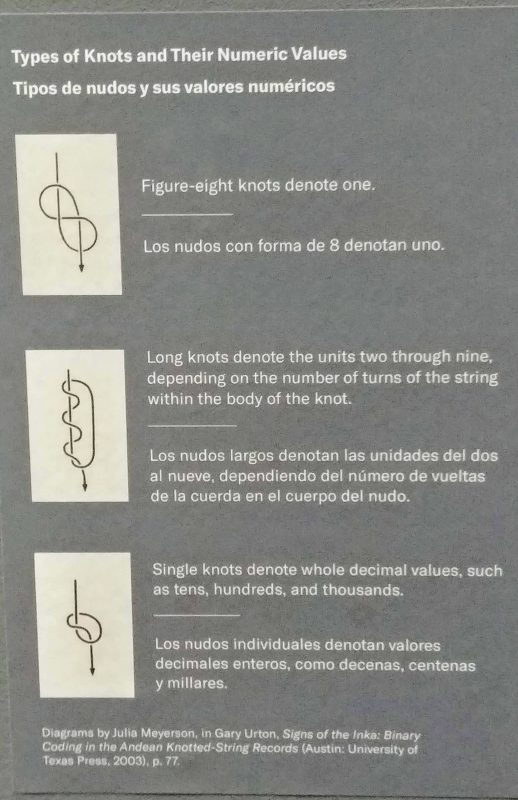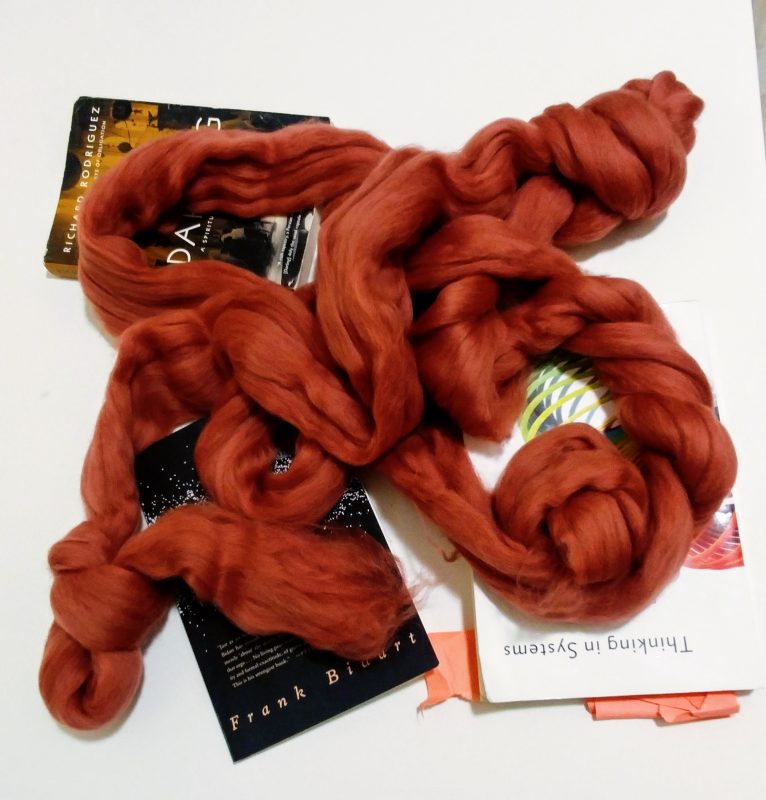That It May Go On
Posted on October 25, 2018Words are acts.
-Octavio Paz [17]
In the center of the room sheets of carded fiber swoon gravely from the rafters. Each wide cord is complicated by fleshy knots, amplifying gravity’s insistence. Even as the whorl troubles the wool’s direction, crenulating the swath as it enters and exits its fold, tightening upon itself, it becomes a point of intimacy. This stand of wool is a story in fiber, inviting and mysterious, a place and pattern I want to participate in and inhabit, accessing its meaning like nature.

Disappeared Quipu, by Cecilia Vicuña, at the Brooklyn Museum, 2018. Photo: A. Hansen
Disappeared Quipu, an installation by Cecilia Vicuña, is one iteration of Vicuña’s decades long artistic quipu practice, realized in sculptural fiber objects, poetry, and physical performance. Quipu are Incan record keeping devices that organize meaning in knots and color, and store it in clustered strings.
Historically, it’s likely that the majority of quipus were used for accounting purposes, ledgers of everything from grain stores to census information, [1] but there is evidence that literary quipu also existed, recounting histories or legends by pairing a system of woven pictograms with the knotting system of numeric quipus. There is debate whether these quipus are phonetic or semasiographic. [2, 3] The practical use of these “talking knots” vanished as Conquistadors laid claim to Andean South America. The Roman Catholic Church banned quipus as “idolatrous objects,” [5] and use of written and spoken Spanish was adopted. [4] Some quipus became ritual objects and have been found, well preserved by the arid conditions of the region. [6]

Narrative Quipu, Incan, 1400-1532, Peru. The Brooklyn Museum, 2018. Photo: A. Hansen

Exhibition display material. Cecilia Vicuña: Disappeared Quipu, Brooklyn Museum, 2018. Photo: A. Hansen
Through her engagement with quipu, Vicuña retrieves and practices an expanded concept of quipu. Quipu offered the Quechua a system for both mapping and understanding themselves, through space and time. They not only used the quipu for accounting, but conceptualized themselves, the whole of their humanity, as quipu. Cusco, a city, would be understood as a great quipu, its streets radiating out into the world, like strings, Vicuña says.The knots would become sacred sites – not necessarily physical – that provided places for transformation, for passing between dimensions. “So that tells you that for everything, there are more than one dimensions of a species, of naming, of understanding. It’s the same with the quipu.”
[7]
Scholar Donna Haraway’s compound concept of figuring, which unabashedly makes a hydra of “science fiction, speculative fabulation, string figures, speculative feminism, science fact, so far,” [8] understands string figures to be concurrently the action of following an event or system’s metaphoric thread, the actual thread or materiality being tracked, and the multidirectional passing and receiving of information and relationship that is not separate from action or object/event – a “becoming-with each other in surprising relays.”[9]

Materials for quipu play. Photo: A. Hansen
Vicuña’s describes her discovery of quipu making as a multi-temporal becoming-with. “The first quipu work that I did was called El quipu qui recuerda nada (The quipu that remembers nothing). The concept of it was a sort of visual quipu that was a mental thread crossing one side of my room to the next. So, I wrote it down and I still have that note. And I think that’s the beginning of the totality of my work. Because it was a speaking back to the erasure of memory and to the acknowledgement that your work exists in relation to other works, therefore forming a quipu. Instinctively, by incorporating myself into the quipu and the quipu into myself, I was acting, into the reciprocal sphere of thought that the quipu manifested itself in.” [10]
El quipu qui recuerda nada was work which happened within Vicuña’s being and, in her view, made possible all her subsequent work. It was a “physical anticipation of the non-physical connection in the real space of the relationship.” [11] It was also the physical retrieval of that connection within the temporal space of a relationship to quipu making claimed from a place of deep memory and wide time, where it has been sequestered or abiding. The person who knows how to speak (or make or think) in the string language “is tying the knot and speaking of the time. Of that time, and to the time, and of the time – all of it at once.” [12]
Through her quipu work, Vicuña creates web of relationship, bringing viewer into contact with viewer; into confrontation with language, symbol, and action; into a confusion of time, a question of memory, and the violence of history. The quipu, made from traditional fibers, are loud in form but silent of the technical code of their traditional predecessor. [13] Disappeared Quipu is in communication with all of this, and also brings forth the violence of the 1973-1990 Pinochet dictatorship in Chile, which Vicuña narrowly missed, leaving for her studies in 1971. Thousands of people were murdered or “disappeared” during the regime. [13] Vicuña’s quipu elides time and “brings the dead into active presence.” [14] The violence of disappearing ripples through the work, subsuming and birthing civilizations, individuals, language, economies, and meaning. It may be that “our information streams are composed primarily of language. Our mental models are mostly verbal. Honoring information means above all avoiding language pollution – making the cleanest possible use we can of language.” [15] But in Vicuña’s work “ontologically heterogeneous partners become who and what they are in relational material-semiotic worlding” [16] – a worlding which radiates from the systems of meaning embodied in the quipu where language becomes material action.
-AH
Sources:
-
- Quipu, Lawrence Lo, www.ancientscripts.com
- Talking Knots of the Inca, by Viviano Domenici and Davide Domenici. Archaeology, vol. 49/No. 6, November/December 1996.
- Quipu, Wikipedia entry.
- Quipu, Wikipedia entry.
- Cecilia Vicuña: Disappeared Quipu, exhibition material. Brooklyn Museum, 2018.
- Threads that speak: How the Inca used strings to communicate, National Geographic. Senior Producer: Sarah Joseph. March 10, 2017.
- kNot a QUIPU: an interview with Cecilia Vicuña, Video by Sabrina Gschwandtner, Edited by Tara Hart. New York, September 22, 2005
- Staying with the Trouble: Making Kin in the Chthulucene, by Donna J. Haraway. Duke University Press, 2016. Pg. 2
- Staying with the Trouble: Making Kin in the Chthulucene, by Donna J. Haraway. Duke University Press, 2016. Pg. 3
- kNot a QUIPU: an interview with Cecilia Vicuña, Video by Sabrina Gschwandtner, Edited by Tara Hart. New York, September 22, 2005
- kNot a QUIPU: an interview with Cecilia Vicuña, Video by Sabrina Gschwandtner, Edited by Tara Hart. New York, September 22, 2005
- kNot a QUIPU: an interview with Cecilia Vicuña, Video by Sabrina Gschwandtner, Edited by Tara Hart. New York, September 22, 2005
- History: Military Regime, thisischile.cl
- Staying with the Trouble: Making Kin in the Chthulucene, by Donna J. Haraway. Duke University Press, 2016. Pg. 8
- Thinking In Systems: A Primer, by Donella H. Meadows, edited by Diana Wright. Sustainability Institute, 2008. 174
- Staying with the Trouble: Making Kin in the Chthulucene, by Donna J. Haraway. Duke University Press, 2016. Pg. 13
- Language is Migrant, by Celcilia Vicuña. Poetry Foundation, April, 2016.